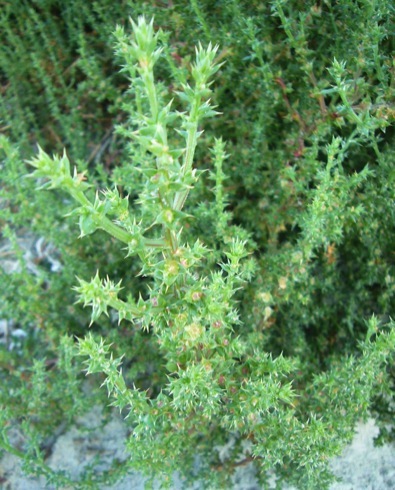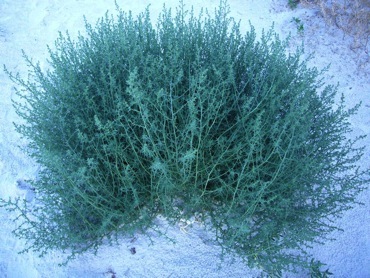Salsola kali: Noxious Weed, Nibble & Green
When you first encounter a Russian Thistle it is the very last plant you would consider edible. Wiry, tough, sharp, pin prickly, irritating. In fact, it kind of reminds you of a green sand spur on steroids.
However, the young shoots and tips of the growing plant are edible raw and actually quite palatable and pickable. Cooked like greens they’re even better. As the plant ages, though, it grows tough and formidable. Also called Tumbleweed and Windwitch, dried ones tumbling across the HD screen are now classic visual cues of desolation in Western-type movies.
The most reliable to eat is the Salsola kali (SAL-so-la KAH-lee) which is believed to have arrived in the United States in the early 1870s in southern South Dakota. Some Russian immigrants moved to the town of Scotland in Bon Homme County. They had some Salsola seed in with their flax seed. By 1873 local botanists identified the new weed in town. By 1895 it had reached from the remote north middle of the country to New Jersey and California. That’s remarkable distribution in 30 years considering the plant had only summers to move.
Professor Lyster Hoxie Dewey, who worked for the US Department of Agriculture, said in two reports in 1893 and 1894 he knew how the plant was spreading: The trains. That may seem obvious to us now but back then it was hard work and good insight. In Illinois he documented Salsola along railroad tracks and gave specific locations. The plant was not yet an “obnoxious weed” but Dewey saw the potential problem. He recommend railroad get rid of the plant wherever they found it and he theorized that by using the railroad and the wind the plant could be come a severe problem. Right man, right place, right observation, right idea, and completely ignored.
In fact, let’s give Dewey his due. People who got it right should be given some recognition. Lyster Hoxie Dewey (1865–1944) was an American botanist born in Cambridge, Michigan. In 1888 he graduated from Michigan Agricultural College where he went on to teach botany for two years. He was an assistant botanist for the United States Department of Agriculture from 1890 to 1902 and then botanist in charge of fibre investigations. By 1911 he was the U.S. representative to the International Fibre Congress in Surabaya, Java. Nice work if you can get it. His publications were mostly bulletins for the USDA on the production of fibre from flax, hemp, sisal, manila plants, on the classification and origin of the varieties of cotton, and what brought him to our attention, investigations on grasses and troublesome weeds.
Some 117 years after Dewey’s Salsola report the current and perpetually out-of-date USDA distribution map shows Salsola to be in coastal areas only. However, it has been reported throughout the United States and Canada, particularly in dry and or salty areas including along northern (salted) roads, along fences/gullies in the plains states, and southwest deserts. Millions are spent each to get rid of it especially along highway right-of-ways. It can rapidly take over open land via up to 200,000 seeds per plant, the wind, and …yeph… the trains.
If your Tumbleweed is a Salsola but not the kali, you will need to verify its edibility with a local expert. Elias and Dykeman (2008) say related species in the desert southwest of the United States are edible. This is where botanists let foragers down. They can’t quite decide if there is one species of Salsola ( the kali ) and a lot of varieties of that one species, or, if there are several species of Salsola. (Note: Edibility is usually not on the botanical radar either.) If that’s not bad enough then one botanist thinks he can improve upon the name so we get different names for the same plant, or plants, or variety, or varieties. That turns it all into a linguistic morass meaning it’s tough to figure out if the plant you are looking is the plant they are talking about. Again, all the more reason to check with a local expert. You don’t need to know the name but you do need to know if it is edible…. Let me put it this way…. whatever the name is the one that grows on the sandy beach due east of me IS edible. Which species is it? Probably Salsola kali var. pontica. Three other Salsola that are known to be edible are S. australis, S. komarovi and S. soda.
Globally, Salsola kali et al is found in Afghanistan, Argentina, Canada, Chile, China, Egypt, Greece, Hawaii, Hungary, Indonesia, Iran, Italy, Japan, Lebanon, Mexico, Morocco, Norway, New Zealand, Pakistan, Poland, South Africa, Turkey, Western Siberia and Russia, where it is native to the southlands. In fact, more than a century ago Russia had to give up several development projects because the Salsola kali just plain got in the way.
Salsola is from the Latin salsa, and means “salted.” Kali (KAH-lee) has many meanings but the one that makes sense to me is Black because the plant was in high demand for soda ash and for that the plant had to be burned. The word also means “good” in Greek. In Hindu mythology, the goddess of destruction and creation is Kali. The English the word “alkali” comes from the Arabic “al qaly” or “from Kali.” Oh, and here is brilliant botanical naming: Pontica (PON-ti-kah) means from Asia Minor, north of the Black Sea, where the plant is native. Talk about redundant….
Young plants make good fodder and grows well in low-water areas. In fact, when dry Salsola is a good source of fuel. It also has been used to make soap since Biblical times. Salsola soap can still be purchased around the Mediterranean.
Now some warnings: The plant, a relative of the Chenopodium, can contain as much as 5% oxalic acid thus folks who are sensitive to oxalic acid should avoid the genus. It is also a severe allergen for some people. And if you eat it when it is too old the shape of the leaves — fat and pointed — will irritate your throat. Lastly, Salsola kali is a host plant of the Sugar Beet Leafhopper. This insect carries curly-top virus, a disease affecting sugar beets, tomatoes, and beans. This puts it on the farmers’ hit list.
Steamed Russian Thistle
Take two cups of shoots or tips (hint, they easily break off when bent.) Rinse and steam as is or cut them up and steam. Season with butter
Russian Thistle Broth
Five cups chicken broth
Two cups Russian Thistle tips or shoots
One potato or Jerusalem artichokes
One onion
Half cup parsley chopped
Half cup watercress chopped
3 cloves of garlic, chopped
One bay leaf
Simmer the potato or Jerusalem artichoke in the broth. Add chopped onion and garlic. Cut Russian Thistle into one inch pieces (this is to assure you have edible pieces and makes it easier to eat.) Chop parsley and watercress, add with the whole bay leaf. Simmer 20 minutes or until the potato et al is done.
Tumbled Rice and Russian Thistle
Four cups Russian Thistle
One cup rice
One cup mustard or radish leaves or any mild green
One teaspoon pepper
One teaspoon garlic powder
A third of a cup of jack or similar cheese shredded.
Cook rice. Steam Russian Thistle tips or shoots. After a few minutes add the rest of the greens to the thistle tips. When greens are cooked, mix with the rice, season, sprinkle with the cheese. Serve hot.
Green Deane’s “Itemized” Plant Profile
IDENTIFICATION: Herb to five feet usually less than three, bushy, branching from base; upright or almost prostrate .Leaves and bracts fleshy, flatish, short, tipped with sharp spines. Flowers with 5 narrow whitish petals, solitary, unstalked. Older branches serpentine, purplish
TIME OF YEAR: Early summer locally, varies with local, can be late summer to fall in other areas, some nearly year round.
ENVIRONMENT: Sandy areas, seashores, some desert environments, salty areas, beside northern roads because of salt, or western roads because of open space, railroad tracks.
METHOD OF PREPARATION: Young shoots raw or cooked, tips of growing plants raw or cooked. Its seeds are reportedly edible but I don’t personally know that.



